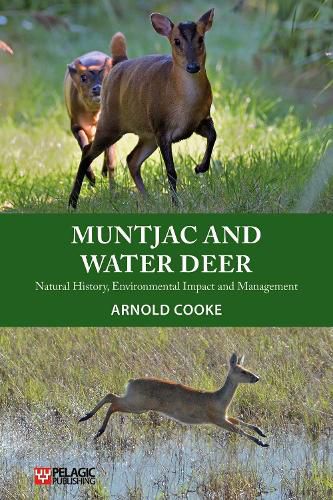Readings Newsletter
Become a Readings Member to make your shopping experience even easier.
Sign in or sign up for free!
You’re not far away from qualifying for FREE standard shipping within Australia
You’ve qualified for FREE standard shipping within Australia
The cart is loading…






Muntjac and water deer were introduced to Britain from East Asia. This book provides a comprehensive overview of their natural history and the management of their environmental impacts.
In lowland England, muntjac deer are one of the drivers of changes in woodland structure and species composition, and many of the principles relating to such woodland impact are also applicable to the activities of other species of deer. Interest in environmental impacts of deer is not solely restricted to woodlands. The highest densities of water deer occur in wetlands, where there is potential for conflict, and considerable numbers are also found on agricultural land. Muntjac have also settled in suburbia and frequently cause impacts there. Conservationists and national decision makers are concerned both about invasive alien species and about increasing deer populations.
The first section covers the natural history of both species including: breeding biology, deer in the field, colonisation of Britain, a detailed look at colonisation in a single county, methods for studying deer populations and a review of deer population numbers. The second section covers environmental impact: risk assessment, impact management, control of muntjac, effect of muntjac browsing and grazing, habitat recovery from muntjac impacts and a study on the impacts of water deer. The section concludes with an overview of management and monitoring.
The costs and benefits of both species are discussed, and questions asked about whether we are getting on top of problems caused by muntjac (locally and nationally) and will water deer turn out to be similar to muntjac? Attitudes and approaches to these species are changing: with water deer we are actively studying whether it might be an environmental problem, not waiting until after it has obviously become one. What will happen to distribution, numbers, impacts and attitudes in the future? Will water deer ever become a suburban animal? What does the future hold for water deer in China and Korea - and how important is the English population as a global conservation resource?
$9.00 standard shipping within Australia
FREE standard shipping within Australia for orders over $100.00
Express & International shipping calculated at checkout
Muntjac and water deer were introduced to Britain from East Asia. This book provides a comprehensive overview of their natural history and the management of their environmental impacts.
In lowland England, muntjac deer are one of the drivers of changes in woodland structure and species composition, and many of the principles relating to such woodland impact are also applicable to the activities of other species of deer. Interest in environmental impacts of deer is not solely restricted to woodlands. The highest densities of water deer occur in wetlands, where there is potential for conflict, and considerable numbers are also found on agricultural land. Muntjac have also settled in suburbia and frequently cause impacts there. Conservationists and national decision makers are concerned both about invasive alien species and about increasing deer populations.
The first section covers the natural history of both species including: breeding biology, deer in the field, colonisation of Britain, a detailed look at colonisation in a single county, methods for studying deer populations and a review of deer population numbers. The second section covers environmental impact: risk assessment, impact management, control of muntjac, effect of muntjac browsing and grazing, habitat recovery from muntjac impacts and a study on the impacts of water deer. The section concludes with an overview of management and monitoring.
The costs and benefits of both species are discussed, and questions asked about whether we are getting on top of problems caused by muntjac (locally and nationally) and will water deer turn out to be similar to muntjac? Attitudes and approaches to these species are changing: with water deer we are actively studying whether it might be an environmental problem, not waiting until after it has obviously become one. What will happen to distribution, numbers, impacts and attitudes in the future? Will water deer ever become a suburban animal? What does the future hold for water deer in China and Korea - and how important is the English population as a global conservation resource?